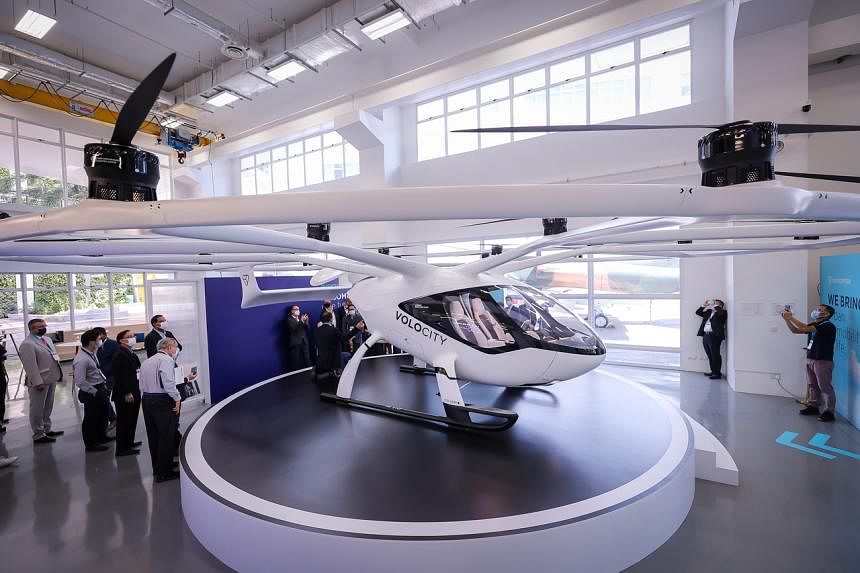
www.straitstimes.com
First air taxi flights in S'pore to take scenic route around Marina Bay if approved
SINGAPORE - Tourists looking for a new way to take in the sights in the Marina Bay area may be able to do so from the sky if a proposed route for the first commercial air taxi flights here gets the nod from the authorities.
The proposed flight over a 12km route, operated by air taxi pioneer Volocopter, is expected to be ready for launch around early- to mid-2024, with the hiring of key staff such as pilots, engineers and service crew expected to start by end-2023 at the latest, said Volocopter's chief commercial officer, Mr Christian Bauer, on Tuesday (July 12).
Mr Bauer spoke to reporters during a tour of a newly launched public exhibition at ITE College Central in Ang Mo Kio, which will showcase a scale model of Volocopter's fully electric urban air taxi VoloCity.
The two-seater aircraft has a range of 35km and a speed of 90kmh, and is part of the German company's longer-term vision for urban air mobility in Singapore.
If all goes to plan, Volocopter's maiden commercial flight here will take passengers from a take-off and landing area in Marina South to the Marina Reservoir and back, going over the Marina Barrage and the Benjamin Sheares Bridge at an altitude of 100m to 150m.
The journey, which will also take in parts of Kallang Basin near Tanjong Rhu, will last about 15 minutes.
Mr Bauer said the proposed route is in "the final approval stage" and studies on the route have already been conducted.
"Why a tourist flight? Because to be quite transparent, Singapore does not have a congestion problem on the ground, but you have around 20 million visitors per year who want to have excitement, an experience. We believe such a breathtaking sightseeing excursion would be a brilliant way to start off," he added.
Another air taxi route around Sentosa island - also aimed at tourists - is next in the pipeline for Volocopter.
In 2019, before the Covid-19 pandemic struck, 19.1 million travellers visited Singapore, spending close to $28 billion.
Mr Bauer said Volocopter is also in discussion with the authorities on the location of its first VoloPort, which is where the air taxi will take off from and land at.
"We need them to break ground at the end of the year or the beginning of next year to really build up that infrastructure to be ready," he added.
Volocopter's air taxis look like small helicopters with multiple mini rotor blades.
But unlike regular choppers, these electric aircraft have been touted as a safer, quieter, more convenient and more environmentally friendly way to travel.
They will take off from and land on vertiports - named for the way the aircraft take off and land vertically. Volocopter said its vertiports take only three to four months to build if they are constructed on cleared land.
Air taxi services in Sentosa and Marina Bay by 2024; flights to Malaysia and Indonesia to follow
Seletar Airport eyes future as a flying taxi hub
It aims to have between four and six of them in Singapore and South-east Asia by 2030.
Earlier this year, the company had laid out longer-term plans to operate cross-border air taxi trips from Singapore to Indonesia and Malaysia.
In the meantime, the firm wants Singapore and Paris to be the first cities its commercial air taxis are flown in, and is in the process of obtaining the necessary regulatory approvals from the Civil Aviation Authority of Singapore (CAAS) and the European authorities. A slew of tests, flight trials and evaluations are being conducted to ensure the air taxis are as safe as commercial aircraft.
Volocopter's chief risk and certification officer, Mr Oliver Reinhardt, said there is a working arrangement between CAAS and the European Union Aviation Safety Agency (EASA) to concurrently validate the VoloCity aircraft.
Certification is expected in early 2024.
Asked about Volocopter's proposed flight routes and certification, Mr Tan Kah Han, CAAS' chief technology officer and senior director at CAAS' Unmanned Systems Group, said only that the authority is working with partners like Volocopter to evaluate possible routes and develop an operating framework here.
He said CAAS is also working with EASA to develop a range of regulations, including on airworthiness, to address and ensure public and aviation safety.
Asked how much each air taxi flight will cost here, Mr Bauer declined to give specific figures. But he said Volocopter's first flights in Singapore will be about 70 per cent to 75 per cent cheaper than the price of a helicopter ride.
According to one local helicopter operator, it costs about $2,500 to charter a helicopter for sightseeing in Singapore, and this is only for the flight itself.
Mr Bauer said the aim in the next five to seven years is to make air taxis as affordable as a premium taxi ride.
By 2030, Volocopter also plans to hire up to 500 direct employees here and induce the creation of another 800 jobs in related sectors.
ITE College Central principal Suresh Natarajan said Volocopter's engineers have already conducted training for ITE lecturers to get familiar with the VoloCity aircraft as part of a feasibility study for maintenance training.
"We are very hopeful that, through this collaboration, we are able to provide new career and development opportunities for the Singapore aviation workforce by embracing new technologies and staying ahead with the... curve."

